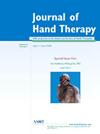Kinesio 胶带和动态胶带对有症状的肩袖肌腱病患者肩肱距离的直接影响。
IF 2.1
4区 医学
Q2 ORTHOPEDICS
引用次数: 0
摘要
背景:有人认为,手臂抬高时肩峰下空间的缩小是肩袖肌腱病的潜在病因之一。目的:本研究旨在比较 Kinesio 贴敷和动态贴敷对有症状的肩袖肌腱病患者肩峰距离(AHD)的直接影响:研究设计:采用两组前测-后测重复测量设计:32 名参与者被随机分配到两组:方法:32 名参与者被随机分配到两组:肌张力绑带组(16 人)和动态绑带组(16 人)。在绑带之前和绑带之后,分别在肩关节外展 0° (静止)和 60° 时通过超声波测量肩关节活动度。采用重复测量方差分析进行统计分析:研究结果表明,两种绑带方法都能显著增加中立位和外展 60° 时的肩关节屈曲活动度。然而,在统计学上,动态绑带比 Kinesio 胶带在中立位和外展 60°时的 AHD 增加幅度更大(p 结论:研究结果表明,动态绑带比 Kinesio 胶带在中立位和外展 60°时的 AHD 增加幅度更大:本研究结果表明,动态绑带技术可能是改善有症状患者肌张力障碍的更有效方法。因此,在进行锻炼之前,动态绑带有可能对临床有益。本文章由计算机程序翻译,如有差异,请以英文原文为准。
Immediate effects of Kinesio taping and Dynamic taping on acromiohumeral distance in individuals with symptomatic rotator cuff tendinopathy
Background
It has been suggested that the reduction in subacromial space during arm elevation is one of the potential mechanisms in the etiology of Rotator cuff tendinopathy. While it is known that Kinesio taping reduces the narrowing of the acromiohumeral distance (AHD) during arm elevation, the effect of Dynamic taping remains unknown.
Purpose
This study aimed to compare the immediate effects of Kinesio taping and Dynamic taping on AHD in individuals with symptomatic Rotator Cuff Tendinopathy.
Study Design
Two group pre-post-test repeated measures design was used.
Methods
Thirty-two participants were randomly assigned to two groups: Kinesio taping group (n = 16) and Dynamic taping group (n = 16). AHD measurements were taken via ultrasound at 0° (rest) and 60° shoulder abduction both before and immediately after taping. Repeated measures ANOVAs were used for statistical analyses.
Results
The study demonstrated that both taping methods led to a significant increase in AHD at both neutral and 60° abduction. However, the increase in AHD with Dynamic taping was statistically greater than with Kinesio taping in both neutral (p < 0.05) and 60° abduction (p < 0.001).
Conclusions
The findings of this study suggest that Dynamic taping techniques may be a more effective approach for improving AHD for symptomatic patients. Therefore, Dynamic taping has the potential to be clinically beneficial before engaging in exercises.
求助全文
通过发布文献求助,成功后即可免费获取论文全文。
去求助
来源期刊

Journal of Hand Therapy
医学-外科
CiteScore
3.50
自引率
10.00%
发文量
65
审稿时长
19.2 weeks
期刊介绍:
The Journal of Hand Therapy is designed for hand therapists, occupational and physical therapists, and other hand specialists involved in the rehabilitation of disabling hand problems. The Journal functions as a source of education and information by publishing scientific and clinical articles. Regular features include original reports, clinical reviews, case studies, editorials, and book reviews.
 求助内容:
求助内容: 应助结果提醒方式:
应助结果提醒方式:


